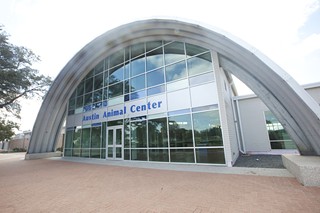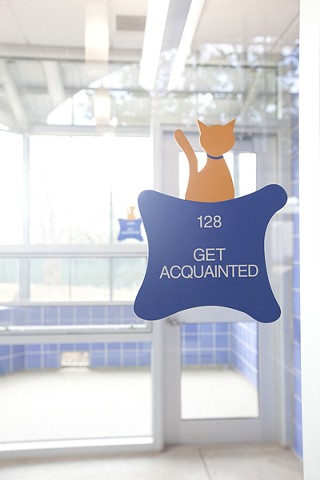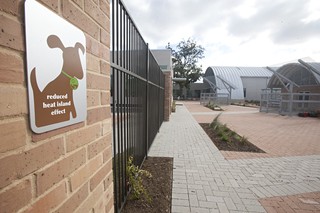Walking the No-Kill Tightrope
With a new shelter, a new director, and a new strategy, Austin's animal welfare program steps into a brave new world. Can it maintain its already delicate balance?
By Josh Rosenblatt, Fri., Nov. 4, 2011
Here's what must happen on Nov. 10 to make sure the scheduled opening of the long-awaited $12 million animal shelter on Levander Loop two days later goes according to plan. First, Item 22 on the City Council agenda, which enables the execution of a temporary license agreement authorizing local animal rescue group Austin Pets Alive! to occupy and operate the current (soon-to-be-former) Town Lake Animal Center on Cesar Chavez as an overflow adoption center, must be pulled from the consent agenda by vote and postponed until council holds a required public Texas Parks & Wildlife Code Chapter 26 hearing later the same day on whether or not to approve licensing the TLAC site for anything other than park use. After the hearing, City Council will vote on the license agreement, and (presuming it's approved) Chief Animal Services Officer Abigail Smith (who, by that point, will have been twiddling her thumbs all day at City Hall while her staff loaded trucks with animals and caravanned them east across I-35 to the new Levander Loop site) and APA! Executive Director Ellen Jefferson will meet somewhere in City Hall to sign the agreement – thereby freeing Smith to leave some 25 animals behind at TLAC as the first official residents of the new APA!-run adoption facility. Finally, that night, Animal Services and APA! will both move into their new facilities. Two days later, with any luck, both will be open to the public.
If any one of those things doesn't happen, however, Austin's new shelter will be overcrowded from day one, and the old TLAC site will be a ghost town.
Junie Marie Plummer, a property agent in the city's Office of Real Estate Services who has spent the last several weeks piloting the TLAC license agreement through the maze of our municipal bureaucracy (and quite a bit of time explaining it all to this reporter), has called this process a "synchronized dance." Others are probably calling it something else.
Diminishing Numbers
Four years ago, when council signed off on the new Austin Animal Center, the goal was to build a new state-of-the-art facility that would give Animal Services staff the tools they need to make and keep Austin "no-kill." Located near Airport Boulevard and Highway 183 on the city's far Eastside, in an area currently populated mainly by storage units and car mechanics, the Levander Loop shelter will feature larger, easier to clean cage spaces; solar panels and other green elements; and an enormous two-story lobby with workstations where 10 adoptions can be facilitated at any one time. The lobby is "designed to be extremely efficient in terms of people flow, and that's going to make a huge difference" for adoption services, Smith recently told City Council's Public Health and Human Services Committee. The new site is also made mainly of sterilizable materials, not prone to flooding (unlike the current site), and 5,000 square feet bigger than the current one – space that will be used to better isolate and care for sick animals, Smith says.
But for all its amenities and ambitions for LEED Gold certification, the new shelter actually has 56 fewer dog kennels than TLAC. Add that to the fact that Austin's No Kill Implementation Plan prohibits euthanizing animals for a lack of cage space, plus the very real possibility that Animal Services will see a spike in shelter intake because people may feel more comfortable (i.e., guilt-free) dropping animals off at a shiny new facility they know is no-kill, and in short order, the city could be facing severe overcrowding. Partly in anticipation, City Council wrote a provision into the no-kill plan (passed in March) handing over the Davenport Building at the current TLAC site to APA! to serve as an overflow adoption facility for the next year (with an additional six-month option) and hopefully, according to Smith, to "facilitate and grow off-site adoption capabilities" for the long-term.
The license agreement, should it come to pass, will represent a new, more formalized chapter in the relationship between the city and APA!. (It will most likely include financial compensation, though the amount is still undetermined.) And it comes at a time when that relationship has become somewhat murkier, with the rescue group gradually reducing the number of animals it has been transferring out of the shelter.
APA!'s role in city animal welfare – to act as a safety net by rescuing the most at-risk animals in the shelter system and either adopting them out or finding them foster homes – is a huge reason Austin was able to reach and maintain an average live-outcome rate of 90% over the first six months of 2011. However, in the wake of that success, APA! has, over the last few months, started expanding its mission beyond Austin into nearby areas, and even going national. "Our organization is built around filling the gaps," says Ellen Jefferson. "Town Lake has made a lot of strides in adopting out animals on their own, so if they're doing that, it doesn't make sense for us to go in there and fight over the same animals. In theory, in an ideal world, our role would continue to decrease as the shelter continues to become more and more self-sufficient."
In September, APA! transferred 182 animals from TLAC. That's down steadily from a peak of 454 in May (that number attributable largely to the first month of kitten season, Jefferson says). But while September saw APA! take in the lowest number of animals from TLAC since December 2010, it also saw a large increase in the number of animals the group rescued from other area shelters. All told, the group transferred 399 animals from shelters in Bastrop, Williamson County, Lockhart, San Antonio, and other nearby areas last month.
Much of that total, of course, has to do with the wildfires that ravaged Bastrop and Williamson counties, leaving many animals homeless and forcing Bastrop shelter workers to evacuate their building. But Jefferson admits her group is expanding its reach beyond Austin, looking to help neighboring communities set up adoption and volunteer programs to achieve no-kill status. "There are a lot more animals at risk everywhere, literally on euthanasia lists," says Jefferson. "And they're really nice, easy animals to adopt, too. Now that Austin is doing so well, it makes sense to share our resources with others."
For the last few months, APA! has also been competing in the ASPCA $100K Challenge – a nationwide contest with a $100,000 prize for the animal adoption agency with the largest increase of its August, September, and October adoption numbers from last year to this year. With two months counted, APA! was leading the field of 49 with a 434-animal hike; ASPCA will announce the winner Nov. 30. Jefferson says that, as part of her group's strategy for winning the three-month ASPCA challenge, she approached shelters in San Marcos and Bastrop about helping them establish volunteer programs. "We offered to set up a pilot program and help rally volunteers and help create a local Pets Alive group that can help them get animals adopted in their own community, rather than taking them all into Austin," Jefferson says, adding that she's also been in talks to help rescue animals from the struggling, overcrowded shelter in San Antonio, though "not in any formal-ized relationship."
Going National
A spokesman for the San Marcos shelter told the Chronicle that Jefferson and FixAustin.org founder Ryan Clinton approached them about taking over their adoption program entirely, but Jefferson says that isn't the case. "San Marcos doesn't have very many resources in adoption at all, so it would be adding a lot of support, but it would be all-volunteer," she says. "The idea was that during the three months, while Austin Pets Alive! is really excited about the challenge, we could help them create the programs that they need and get the volunteer pieces in place, and then after three months, we'd be able to step away and they'd have this unit ready to go and keep going forever."

Jefferson says both the Bastrop and San Marcos shelters turned down APA!'s offer.
Lisa Norwood, public information officer for San Antonio Animal Care Services, told this reporter that APA! responded to a request for information the city put out for a high-volume animal-placement partner to help San Antonio achieve its no-kill goal. Such a partnership, which San Antonio hopes to start at the beginning of 2012, would pay $250,000 annually to the selected partner. In addition, an off-the-record source said that Jefferson was offering those adoption services to the Bastrop shelter for a fee, but Bastrop shelter director Troy Walters told me no such talks had taken place.
Last but not least, APA! recently started American Pets Alive!, an offshoot organization designed to facilitate the implementation of no-kill laws in cities around the country. The group sponsored a no-kill workshop in September to train interested communities in the methods APA! used to help Austin get to the coveted, elusive 90% live-outcome rate.
"We've been contacted by so many different organizations around the country trying to figure out just what we did here to make APA! so successful, how Austin got to this no-kill number," says Jefferson. "And we just don't have time to do all the interviews with people, and we can't do it piecemeal like that, so we thought we should just make it more efficient and put together presentations about each of our programs and invite people here for a conference."
Taken together, these moves represent a remarkable step up in national stature for APA!. At the same time, they may be putting the Animal Services Office and Austin's no-kill status under additional stress. Ask those with experience – say, Smith, who is the only person to have ever successfully run two no-kill shelters – and they'll tell you that for a large municipal shelter like Austin to maintain a 90% live-outcome rate, it needs money, community and political support, and – perhaps most important of all – help from nonprofit rescue groups. Austin has all of these (including a generous budget of about $8 million that went untouched by council during the recent fat-trimming cycle), but mainly it has the active support of rescue groups – and none more so than APA!, which pulls thousands of animals from the shelter every year, making it possible for shelter staff to abide by the rigid euthanasia guidelines of the No Kill Implementation Plan.
So what happens when the rescue group that a shelter depends on cuts back on its local rescue efforts and heads for the big time? Well, on Oct. 14, Amber Rowland, communications manager for the Town Lake Animal Center, issued a press release saying that for two weeks, TLAC had been "significantly over capacity with dogs." "In an effort to get more dogs out of the shelter alive," the release went on, the shelter would be "waiving the adoption fee until the population at the shelter is back down to a manageable and healthy level." The shelter had also seen a significant increase in the number of young kittens it was accepting and requested more foster homes for those kittens and their mothers.

Smith calls this influx of animals partially an "unintended consequence of success" – unintended, though hardly unforeseen. Obviously, reducing the number of animals being euthanized is likely to increase a shelter's animal population; in addition, Smith noted, it's more likely for people who are undecided about taking a pet to a shelter to do so when they find out there's little or no chance that animal is going to be put down. In this regard, no-kill shelters are like moral detours for irresponsible pet owners who possess at least a modicum of shame: They allow them to surrender their pets without the inconvenience of a guilty conscience.
To handle last month's overcrowding, Smith told me that she and her staff "got creative." Besides waiving adoption fees, tripling the number of in-house adoptions, and quadrupling the number of adoption events, they put dogs in unusual parts of the shelter, like quarantine and isolation kennels and pre-operation rooms. Anything, she said, to keep them safe and alive.
Despite those successful adjustments, Smith believes the shift in APA! policy has put a strain on her shelter's resources, resulting in a new, overcrowded reality, just when she and her staff are set to move to a new home and most likely take on more animals. "APA!'s numbers being down is hurting us," she says. "As an open-intake shelter, we can't turn animals away. But right now, we just don't have enough going out." At press time, Smith said TLAC was over capacity by 15 dogs.
That said, Smith acknowledges that being at capacity is simply an inevitable reality for any no-kill shelter. It's a sentiment shared by Jefferson, who actually sees capacity as a good state for the shelter to be at – proof, she says, that the city is putting animal welfare above logistical inconvenience. Besides, she says, APA! is standing by if things get out of hand. "If they're at capacity, and that's what they're mandated to do, I don't think that's necessarily a negative," Jefferson says. "And especially because they're handling it beautifully. Disease is at an all-time low; all the animals are healthy; they're getting so many more adopted than they have before. If we start to dip below 90 percent, I think that can be a real issue, but we're watching; we know every single animal that gets euthanized. So if there's an animal that gets euthanized for a reason that isn't very good – just for space – then that turns into a problem, and we would regroup and come back in. But right now that's just not the case."
Good Intentions
It remains to be seen how the relationship between the shelter and APA! will change after next Saturday's anticipated big move. As we mentioned, the license agreement has yet to be signed, meaning the details have yet to be finalized. But APA! won't be allowed to house animals at Davenport that don't come from the Austin system, and Smith will most likely push for a requirement that APA! takes any and all of the animals she asks them to. Those will most likely be the animals that are "primarily at risk," meaning they require the most resources and/or time to get adopted – including animals with medical issues, burn victims, newborns, puppies with the contagious Parvo virus, and animals recovering from surgery. "I need to be able to move animals through the shelter quickly," says Smith. "I never know what's coming in, and APA! can be there to take care of overflow and harder-to-place animals."
It's not clear if APA! wants to be responsible for the animals hardest to save, but Smith says such an arrangement could mean the difference between having a shelter that's at capacity but still no-kill and one where staff is forced to euthanize.

For Smith, there's no real distinction between a shelter that's at capacity and a shelter that's overcrowded. When an open-intake shelter is full, she says, it doesn't have the necessary "breathing room" to respond to an emergency, say, 20 dogs arriving at once. That line between open-intake and at-capacity is one Smith and all of her fellow no-kill shelter directors carefully monitor, lest overcrowding turn into hoarding, friends in the no-kill movement turn into adversaries, and an animal-welfare job turns into a public relations nightmare.
Just ask Laura Hinze.
Back in February, Hinze was one of five candidates considered for the job of Animal Services director after Dorinda Pulliam stepped down to move to other projects with the city (publicly) and leave behind once and for all the wrath of certain no-kill activists (privately). Hinze was viewed by many as an early favorite for the position, especially after Smith withdrew from consideration. For seven years, Hinze had been the operations director of PAWS Chicago, the largest spay/neuter clinic in the country and that city's largest no-kill humane society. No-kill advocacy groups that had been extremely critical of Pulliam, like FixAustin, said they would support Hinze if the city decided to go that way.
Hinze didn't get the job. A month after removing her name from consideration, Smith resumed her candidacy – partly at the request of the Austin search team – and eventually won the position. Hinze subsequently accepted a job running the Companion Animal Alliance, a nonprofit charged with making the East Baton Rouge Parish Animal Control & Rescue Center in Louisiana a no-kill facility. In 2010, the facility had euthanized more than 6,000 animals.
Not two months after arriving in Louisiana, Hinze resigned from the nonprofit under a cloud of controversy. After CAA announced its arrival at the shelter with a vow to end euthanasia, the number of animals being dropped off at the shelter skyrocketed. Hinze had neither the money nor the infrastructure to respond with a viable adoption or fostering strategy. Complaints of overcrowded cages, unsanitary and unsafe conditions, and animal-on-animal bullying – confirmed by a law enforcement investigation – followed, plaguing Hinze's short tenure. CAA started doing emergency euthanasia by the end of August, and by Sept. 27, Hinze was gone, the casualty of a policy decision built around good intentions and little else.
Smith says she's not surprised that Hinze had as much trouble as she did. "Unequivocally, Hinze's trouble was a result of her trying to get to no-kill," says Smith. "She had the right mindset but not the right experience. The community had no solid foundation and not enough support or money."
Philosophical Differences

Just as in Baton Rouge, the new Austin Animal Center will spend a considerable amount of time at capacity. The difference, says Smith, is that she has both the will and the resources to prevent her shelter from descending into hoarding. "Inevitably, no-kill shelters are going to be at capacity, and one of the very real risks of no-kill is overcrowding and sanitary and health problems," Smith says. "TLAC may be overcrowded, but the medical and sanitary and health conditions are great. When push comes to shove, I'm going to maintain a healthy environment."
As a longtime member of the animal-welfare community, Smith has seen up close just what kind of scrutiny and pressure shelter directors are under from no-kill advocates and how quickly support can turn into vocal disappointment. "There is a ton of pressure on shelter directors, and particularly on new directors there's tremendous pressure to be a change agent," says Smith. "With new directors, any misstep gets scrutinized. The whole country of activists and advocates is watching. But in some no-kill publications, they just say, 'Stop the killing,' as if the desire and the will is enough."
From the time the no-kill philosophy was first advocated as a legitimate shelter option, it has faced criticism from many quarters of the animal-welfare community, because, some say, it will inevitably lead to hoarding, which is what they saw in Baton Rouge and other shelters – shelter staff, under a mandate to reach 90%, desperately trying whatever they could to avoid euthanizing animals. And then, if they fail, those same directors reap the whirlwind – either in the form of disgruntled city officials upset by bad press, bad statistics, bad visuals, and tales of suffering animals, or no-kill advocates calling for the heads of anyone who can't consistently produce the results the movement demands.
As the no-kill movement continues to gather steam and as more municipalities mandate adherence to its guidelines, controversy and conflict are becoming more common at the country's shelters. In addition to Hinze, shelter directors in Miami and Memphis, Tenn., lost or left their jobs within the last month under pressure from advocates pushing for less euthanasia and better live-outcome rates. In New York City and Las Cruces, N.M., meanwhile, campaigns by no-kill advocates to remove what they charge are ineffective, even murderous, shelter directors are running around the clock and have at times bordered on the brutal.
Meanwhile, here in Austin, APA! and other no-kill advocacy groups have a reputation for using less-than-gentle tactics with city officials, shelter staff, and even other volunteers and rescue groups. It's telling that not a single person we spoke to about APA! and FixAustin.org for this article was willing to go on the record – yet the Chronicle was told numerous stories of APA! volunteers bullying other volunteers at TLAC who had filed reports about the bad behavior or poor health of a shelter animal. One person, who has fostered numerous cats to successful home placements, spoke about receiving "humiliating, abusive, and degrading" phone calls from APA! volunteers criticizing her for leaving an animal at TLAC. It's a story echoed several times by several people – all of them afraid to speak freely for fear of retaliation.
And then there was the incident in early September during the Central Texas wildfires, when, shelter staff has said, representatives of APA! – though not claiming to speak on behalf of the group – badgered Smith, TLAC staffers, and staffers from the Houston SPCA, and then tried to prevent an HSPCA transport vehicle from taking 19 TLAC animals to Houston – this following a call from FixAustin.org's Ryan Clinton on Facebook to "head down to TLAC to protest the transfer." More than one source said an APA! volunteer went so far as to trail the vehicle east on Highway 290, though no one's saying anything on the record. (See "Fun With Animals," Sept. 30.)
Jefferson told me that even if these accusations are true, they are neither sanctioned by APA! nor representative of its message or methods. "There's no way we could be in control of every single thing, even if it wasn't a passionate group of animal people," she says. "We just have so many people involved. But I think that we have a strong statement that everybody listens to in the orientation, and everybody understands that we've got to be positive and look on the bright side and keep focused on the animals we're saving and not the ones that we're not."
As for Smith, she's aware of just how precarious a shelter director's job security is these days and just how tenuous Austin's hold on no-kill may be. Yet she says she's not worried about her job or her standing. In the age of no-kill, she says, controversy and conflict are just part of the shelter director's job.
"I do what I think is right, and I think the numbers show that we're doing something right," Smith says. "I stand by every decision. I can't worry about the protests and the possibility of angry people. I'm not in this to get elected one day."
Besides, with a 94% live-outcome rate for September, for the moment at least she just might be untouchable.
Got something to say on the subject? Send a letter to the editor.














